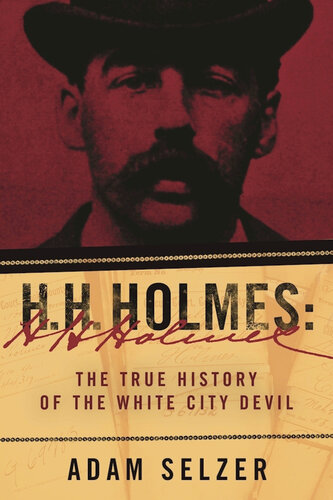
H. H. Holmes
The True History of the White City Devil
کتاب های مرتبط
- اطلاعات
- نقد و بررسی
- دیدگاه کاربران
نقد و بررسی

January 23, 2017
Was late 19th-century mass murderer H.H. Holmes motivated more by psychological compulsions than practical concerns? Selzer (Ghost of Chicago) suggests the latter, diverging from the perspective put forth in Erik Larson’s The Devil in the White City. He works hard to assemble historical evidence that strays from accounts by Larson, and others, but he never loses sight of the fact that Holmes “almost certainly killed at least nine people, ruined the lives of numerous others, and seemed to feel very little guilt about it.” This highly readable account of the case walks readers through Holmes’s nonviolent crimes before getting to his first murder. Selzer believes that Holmes’s 1891 killing of Julia Conner, a woman he had sued for nonpayment of a loan, was, like his others, committed, not out of bloodlust, but as a “necessary part of furthering his swindling operations and protecting his lifestyle.” He makes a convincing argument that current perceptions of Holmes are not always solidly grounded, even as he concedes that there’s “a lot of mystery left to be solved” about the case, a concession that will lead many aficionados of quality true-crime narrative to monitor his Mysterious Chicago blog for updates.

February 15, 2017
An attempt to unmask an infamous mass murderer.In this occasionally thrilling new biography of H.H. Holmes (1861-1896), who received renewed attention in 2003 when Erik Larson published The Devil in the White City, Mysterious Chicago tour guide and author Selzer (Just Kill Me, 2016, etc.) recharacterizes Holmes as a small-time con man who was likely guilty of a series of murders in Chicago. In his introduction, the author makes his argument clear. Holmes, he writes, is said to have killed more than 200 people in his "murder castle," but he was only actually accused of killing one person at that location. Unfortunately, the author doesn't make clear from the beginning that he believes Holmes killed many more people, with the other crimes occurring elsewhere. Immediately, Selzer launches into a history of Holmes the con man, and it is only a third of the way into the book that he begins to explore the other murders he suspects Holmes is guilty of committing. Selzer's attempt to understand Holmes by delving deep into his early history of insurance and mortgage fraud and bigamy is initially intriguing on a psychoanalytical level, but it keeps the later portions of the story, which focus on the murders, from feeling like a natural part of the narrative. The author's research is unquestionably impressive, and he effectively exposes how the Holmes legend became what it is today based mostly on conjecture and gossip. But for all the new information Selzer brings to light, large chunks of the story are plodding and confusing. Few readers will argue with the author's assertion that it is the unfounded nature of the legends surrounding him for which Holmes is an intriguing figure, but a combination of disjointed storytelling and unnecessary minutiae slows the pace. A passion for Holmes lore will lead to appreciation for the depth of background and lesser criminal exploits described in great detail, but the audience will remain limited.
COPYRIGHT(2017) Kirkus Reviews, ALL RIGHTS RESERVED.

Starred review from March 15, 2017
H.H. Holmes is widely considered to be America's first real serial killer, thanks to books such as Erik Larson's Devil in the White City painting him as such. Selzer (host, Mysterious Chicago podcast), however, seeks to debunk much of the fictionalized and sensational aspects of Holmes's alleged killing spree during the 1893 Chicago World's Fair in this comprehensive and intriguing account. Many accepted estimates put his kill count at somewhere between 30 and 200; Selzer, thanks to exhaustive research of previously undiscovered and ignored primary sources, narrows that down to four confirmed murders: Holmes's business partner, Benjamin Pitezel, and three of Pitezel's children. Selzer sets the record straight with regard to Holmes lore--he didn't lure young, single women into his "murder castle" in Englewood during the World's Fair, and his "castle" never functioned as a hotel. In fact, Holmes was much more notorious for his insurance fraud schemes. According to Selzer, much of Holmes lore came from unfettered sensationalized journalism, rampant gossip, unreliable witnesses, and Holmes himself--he was a compulsive liar and probably enjoyed the notoriety before he was sentenced to death. VERDICT A thoroughly enthralling piece of history that will partner well with Martin Scorsese's film adaptation of Devil in the White City, which releases later this year.--Tyler Hixson, School Library Journal
Copyright 2017 Library Journal, LLC Used with permission.

























دیدگاه کاربران